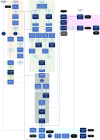A Standardized Pipeline for Assembly and Annotation of African Swine Fever Virus Genome
- PMID: 39205267
- PMCID: PMC11359534
- DOI: 10.3390/v16081293
A Standardized Pipeline for Assembly and Annotation of African Swine Fever Virus Genome
Abstract
Obtaining a complete good-quality sequence and annotation for the long double-stranded DNA genome of the African swine fever virus (ASFV) from next-generation sequencing (NGS) technology has proven difficult, despite the increasing availability of reference genome sequences and the increasing affordability of NGS. A gap analysis conducted by the global African swine fever research alliance (GARA) partners identified that a standardized, automatic pipeline for NGS analysis was urgently needed, particularly for new outbreak strains. Whilst there are several diagnostic and research labs worldwide that collect isolates of the ASFV from outbreaks, many do not have the capability to analyze, annotate, and format NGS data from outbreaks for submission to NCBI, and some publicly available ASFV genomes have missing or incorrect annotations. We developed an automated, standardized pipeline for the analysis of NGS reads that directly provides users with assemblies and annotations formatted for their submission to NCBI. This pipeline is freely available on GitHub and has been tested through the GARA partners by examining two previously sequenced ASFV genomes; this study also aimed to assess the accuracy and limitations of two strategies present within the pipeline: reference-based (Illumina reads) and de novo assembly (Illumina and Nanopore reads) strategies.
Keywords: ASF; ASFV; African swine fever; African swine fever virus; next-generation sequencing; pipeline.
Conflict of interest statement
The authors declare no conflicts of interest.
Figures



References
-
- Le V.P., Nguyen V.T., Le T.B., Mai N.T.A., Nguyen V.D., Than T.T., Lai T.N.H., Cho K.H., Hong S.K., Kim Y.H., et al. Detection of Recombinant African Swine Fever Virus Strains of p72 Genotypes I and II in Domestic Pigs, Vietnam, 2023. Emerg. Infect. Dis. 2024;30:991–994. doi: 10.3201/eid3005.231775. - DOI - PMC - PubMed
-
- Carriquiry M., Elobeid A., Swenson D., Hayes D. Impacts of African Swine Fever in Iowa and the United States. Center for Agricultural and Rural Development; Ames, IA, USA: 2020.
Publication types
MeSH terms
Grants and funding
LinkOut - more resources
Full Text Sources
Miscellaneous

